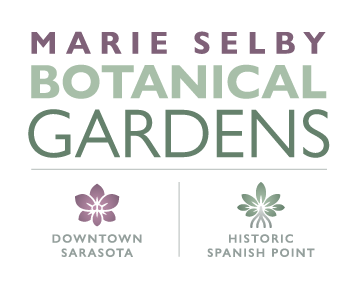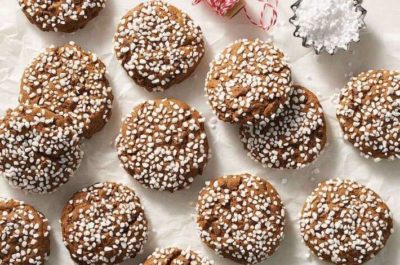As we prepare our favorite holiday cookies and baked goods, you may be wondering where these popular ingredients originate from. Well, on your next visit to Selby Gardens’ Downtown Sarasota campus, you will not have to look extremely far, as many of the common holiday baking ingredients can be found growing throughout the Gardens. We wanted to spotlight a few of our favorites and provide a recipe inspired by these ingredients to bring some festive smells into your own kitchen.
Sugar Cane (Saccharum officinarum):
Many know sugar as the key sweetener in most baking recipes, but some of you may not be aware that most sugar is derived from sugarcane, an exceptionally large and robust grass! Similar to bamboo, another member of the grass family (Poaceae), sugarcane is very durable, and their young stems can be sharp and prickly so harvesting them can be difficult. Once the stems reaches maturity, they are cut and the juices inside are extracted and boiled down to create molasses and sugar. Since their stems are so strong, often after the sugar is removed, the stem is used to create cardboard boxes or paper. Sugarcane originated in New Guinea but is now widely cultivated in the tropics and subtropics around the world, including right here in Florida.
Sugarcane in the Edible Garden at Marie Selby Botanical Gardens’ Downtown Sarasota campus (Photos by Sandra Robinson)
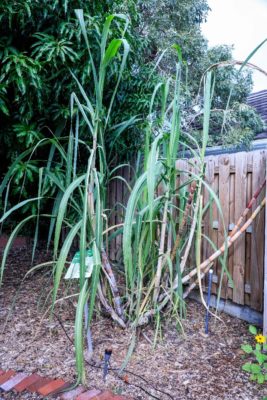
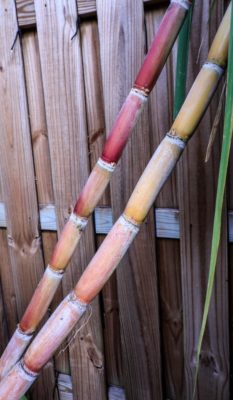
Culinary Ginger (Zingiber officinale):
Ginger (family Zingiberaceae) is an extremely popular spice and is consumed not only for its flavor but for medicinal purposes. This plant, originally from Asia, is common in not only baked dishes but also in stir fries or soups. If you enjoy the flavor of ginger, it can be easily grown in your own garden. However, you may want to contain your plant to a large pot if you do not have a lot of room in the garden for it to spread out, as it will. Your new crop of ginger can easily be started from a piece of the root purchased at the grocery store. Once your ginger plant matures, simply dig enough of the root needed for your dish, and leave the remainder of the plant to continue growing and producing new roots for future use. Another culinary spice and close relative, Turmeric (Curcuma longa) can be grown much the same way, though unlike ginger, the leaves die to the ground seasonally. An example of this lush plant can be found next to the edible garden within the Children’s Rainforest Garden at the Downtown Sarasota campus.
Culinary ginger in the Children’s Rainforest Garden at MSBG’s Downtown Sarasota campus. (Top) the mature plant, (Bottom) the edible root. (Photos by Sandra Robinson)
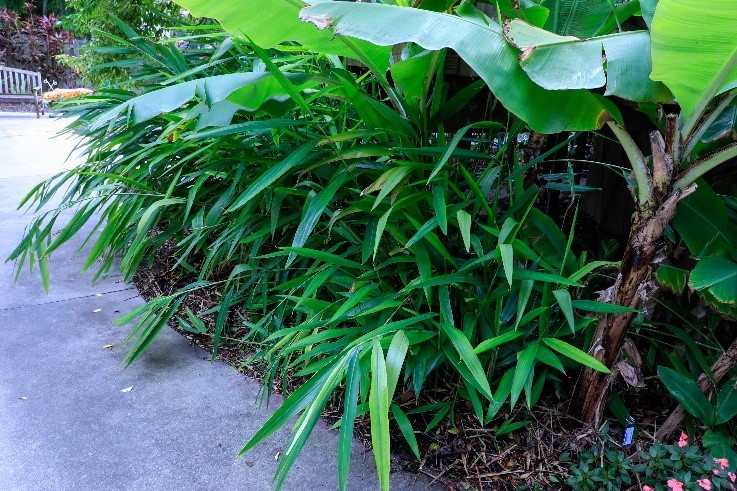
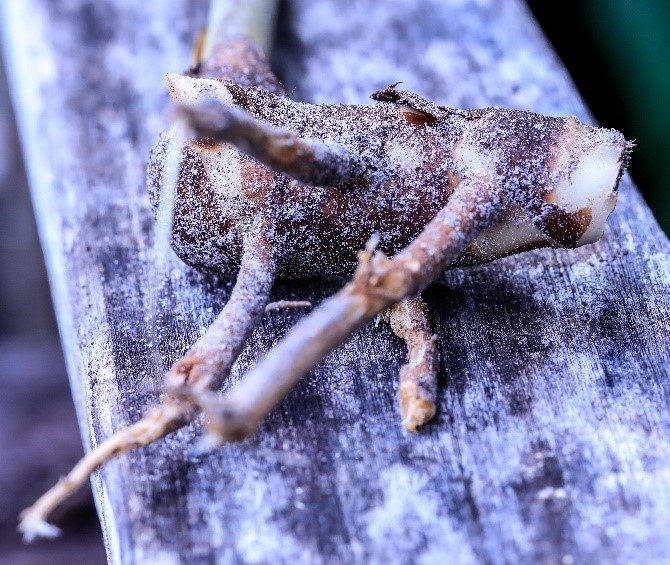
Vanilla (Vanilla planifolia, V. pompona, V. odorata & V. x tahitensis):
Vanilla is an important ingredient 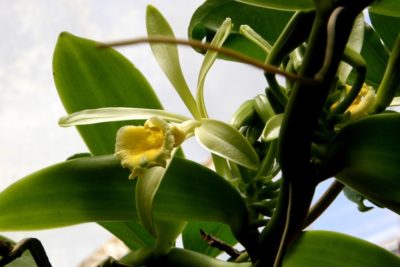 in many recipes, as well as in many products on our grocery store shelves, including fragrances and cosmetics. This popular flavoring comes from one of several species of vining orchids (family Orchidaceae); the most widely used species in the commercial trade is Vanilla planifolia, but other species and hybrids with high vanillin content have also been used. The parent plants originated in the New World tropics, from which several Vanilla species were brought to the Society Islands and elsewhere in the Old World tropics by European powers looking to wrest control of the cultivation and production of Vanilla from Spain. Until the mid-19th century, the Spanish colony of Mexico was the chief producer of vanilla. In 1819, French entrepreneurs shipped Vanilla fruits to the islands of Réunion and Mauritius in hopes of producing vanilla there, but without their native pollinators in the New World tropics, they failed to produce fruit. It wasn’t until 1841, when it was discovered how to rapidly hand-pollinate the flowers, that the industry began to thrive, producing the first “Bourbon vanilla” ( Île Bourbon is an older French name for Réunion). Plants were eventually sent from Réunion to the Comoros, Seychelles, and Madagascar. To this day, Madagascar leads the world in Vanilla production with 38% of global production in 2018 (FAO 2019). Vanilla was, and remains, an extremely valuable commodity and yearly production is never enough to meet demand, so the price tends to be high. Imitations abound, but the best extracts still come from the seed capsule or “bean” of the Vanilla orchid.
in many recipes, as well as in many products on our grocery store shelves, including fragrances and cosmetics. This popular flavoring comes from one of several species of vining orchids (family Orchidaceae); the most widely used species in the commercial trade is Vanilla planifolia, but other species and hybrids with high vanillin content have also been used. The parent plants originated in the New World tropics, from which several Vanilla species were brought to the Society Islands and elsewhere in the Old World tropics by European powers looking to wrest control of the cultivation and production of Vanilla from Spain. Until the mid-19th century, the Spanish colony of Mexico was the chief producer of vanilla. In 1819, French entrepreneurs shipped Vanilla fruits to the islands of Réunion and Mauritius in hopes of producing vanilla there, but without their native pollinators in the New World tropics, they failed to produce fruit. It wasn’t until 1841, when it was discovered how to rapidly hand-pollinate the flowers, that the industry began to thrive, producing the first “Bourbon vanilla” ( Île Bourbon is an older French name for Réunion). Plants were eventually sent from Réunion to the Comoros, Seychelles, and Madagascar. To this day, Madagascar leads the world in Vanilla production with 38% of global production in 2018 (FAO 2019). Vanilla was, and remains, an extremely valuable commodity and yearly production is never enough to meet demand, so the price tends to be high. Imitations abound, but the best extracts still come from the seed capsule or “bean” of the Vanilla orchid.
These special orchids can successively bloom at any time of year (usually in the summer months in Florida), and outside of extreme South Florida where four native species of Vanilla grow, hand pollination is usually necessary to produce capsules. Within the Tropical Conservatory, at Selby Gardens’ Downtown Sarasota campus, both Vanilla pompona and V. planifolia grow year-round. You can see the thick, long, winding vine of V. pompona on the pergola, and the more slender V. planifolia growing along the rock wall, but you may have to search diligently for the rare yellow flowers that only occasionally appear among the vines of both species.
Cacao or Cocoa (Theobroma cacao):
No holiday season is complete without chocolate, and we have the cacao tree (family Malvaceae) to thank for this popular ingredient. Carl Linnaeus must have really liked chocolate, for he named the genus Theobroma, meaning “food of the gods” in Greek. The plant creates large yellow fruit that contain pulp and “beans” or seeds. In a year, most cacao trees will produce at least 70 pods containing over 2,000 beans in all! During the harvesting process, the thick pulp and seeds are removed from the rind of the fruit, piled together, and allowed to ferment until the pulp liquefies and is drained away. The liquid is often fermented further to produce an alcoholic beverage, while the remaining seeds are collected and taken to a drying facility where they are further fermented and dried. The dried seeds are then bagged and shipped overseas to a plant where they are roasted, de-shelled, and processed into cocoa, the primary ingredient of chocolate. Though now widely cultivated in the tropics, the cacao plant originated in the Amazon basin, and may have been first cultivated in lowland Peru and Ecuador before being spread into Mesoamerica, where it was adopted as currency as well as food by the Maya, Olmec, and Aztec. The plant and its “divine” fruit was first encountered by European explorers in the 16th century, during the Spanish Conquest. The rest is history. You can see these unique yellow pods within the Tropical Conservatory at Selby Gardens.
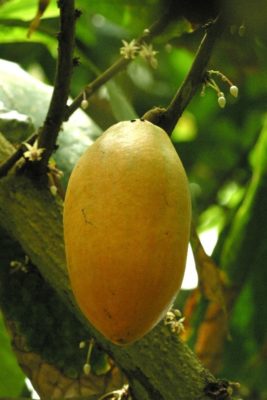
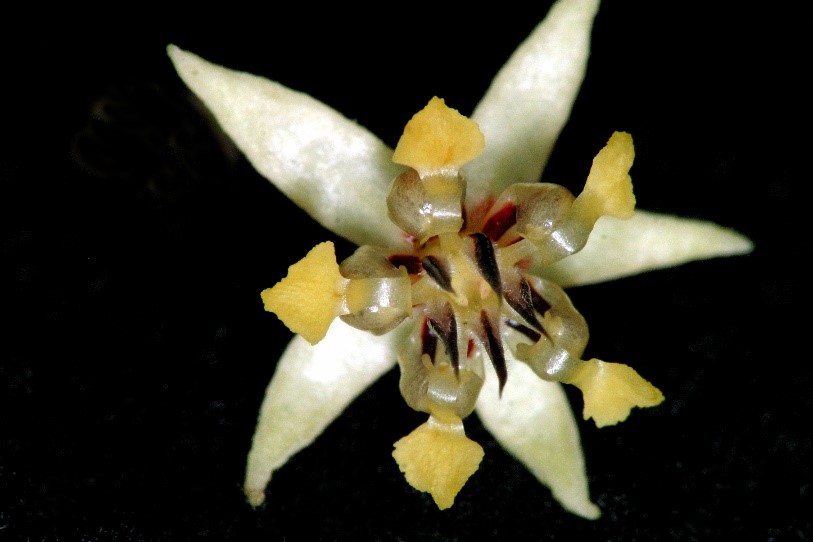
Cacao tree in bloom and fruit at the Tropical Conservatory at MSBG’s Downtown Sarasota campus; a close-up of the ripe fruit (left); and a single cacao flower (right). (Photos by Phil Nelson)
Let’s Get Baking!
Put all of these tasty ingredients together in this King Arthur Baking Company recipe for Chocolate Ginger Bread Cookies!
Please Note: Although we mention the locations of these edible plants at Marie Selby Botanical Gardens, we ask that you do not take or disturb any of the plants that are on Selby Gardens. The plants that grow and are on display at Selby Gardens are part of our living plant collection and are used for educational purposes. Please keep these plants where they are so other guests can enjoy them too.
Resources:
http://www.missouribotanicalgarden.org/PlantFinder/PlantFinderDetails.aspx?taxonid=285293
http://www.missouribotanicalgarden.org/PlantFinder/PlantFinderDetails.aspx?kempercode=a763
https://www.aos.org/orchids/orchids-a-to-z/letter-v/vanilla.aspx
https://www.britannica.com/plant/cacao
https://www.kingarthurbaking.com/recipes/chocolate-gingerbread-cookies-recipe
Christel Brunschwig, François-Xavier Collard, Sandra Lepers- Andrzejewski and Phila Raharivelomanana (2017). Tahitian Vanilla (Vanilla ×tahitensis): A Vanilla Species with Unique Features, Active Ingredients from Aromatic and Medicinal Plants, Hany A. El-Shemy, IntechOpen, DOI: 10.5772/66621. Available from: https://www.intechopen.com/books/active-ingredients-from-aromatic-and-medicinal-plants/tahitian-vanilla-vanilla-tahitensis-a-vanilla-species-with-unique-features
FAO Global Statistical Yearbook (2019). “Crops, Vanilla”. Retrieved 17 December 2020.
